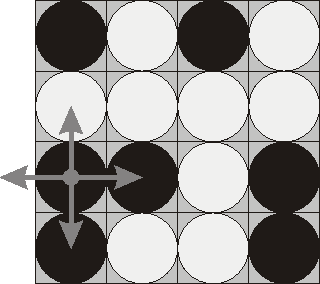Flip Game Poj1753
2015-06-23 14:56
204 查看
Flip Game
Description
Flip game is played on a rectangular 4x4 field with two-sided pieces placed on each of its 16 squares. One side of each piece is white and the other one is black and each piece is lying either it's black or white side up. Each
round you flip 3 to 5 pieces, thus changing the color of their upper side from black to white and vice versa. The pieces to be flipped are chosen every round according to the following rules:
Choose any one of the 16 pieces.
Flip the chosen piece and also all adjacent pieces to the left, to the right, to the top, and to the bottom of the chosen piece (if there are any).

Consider the following position as an example:
bwbw
wwww
bbwb
bwwb
Here "b" denotes pieces lying their black side up and "w" denotes pieces lying their white side up. If we choose to flip the 1st piece from the 3rd row (this choice is shown at the picture), then the field will become:
bwbw
bwww
wwwb
wwwb
The goal of the game is to flip either all pieces white side up or all pieces black side up. You are to write a program that will search for the minimum number of rounds needed to achieve this goal.
Input
The input consists of 4 lines with 4 characters "w" or "b" each that denote game field position.
Output
Write to the output file a single integer number - the minimum number of rounds needed to achieve the goal of the game from the given position. If the goal is initially achieved, then write 0. If it's impossible to achieve the
goal, then write the word "Impossible" (without quotes).
Sample Input
Sample Output
4
和上道题目类似只不过不用标记并且对一维数组的转化方法也并不难。
#include <iostream>
#include<cstdio>
#include<cstring>
#include<algorithm>
using namespace std;
int map[20];
struct node
{
int x,ans,a[20];
} q[100010];
void bfs()
{
int i,j,k,s=0,e=0;
node f1,f2;
for(i=0; i<16; i++)
f1.a[i]=map[i];
f1.x=f1.ans=0;
q[s++]=f1;
while(s>e)
{
f1=q[e++];
int ss=0;
for(i=0;i<16;i++)
ss+=f1.a[i];
if(ss==0||ss==16)
{
cout<<f1.ans<<endl;
return ;
}
for(i=0;i<16;i++)
{
f2=f1;
if(f2.x<=i)
{
if( (i-4)>=0 )//上一行
f2.a[i-4]=1-f2.a[i-4];
if( (i+4)<=15 )//下一行
f2.a[i+4]=1-f2.a[i+4];
if( (i%4-1)>=0 )//左列
f2.a[i-1]=1-f2.a[i-1];//注意是下标是i-1而不是i%4-1;
if( (i%4+1)<4 )
f2.a[i+1]=1-f2.a[i+1];
f2.a[i]=1-f2.a[i];
f2.x=i+1;
f2.ans++;
q[s++]=f2;
}
}
}
puts("Impossible");
return ;
}
char s[4];
int main()
{
int n,m,i,j,k;
for(i=0; i<4; i++)
{
cin>>s;
for(j=0; j<4; j++)
{
if(s[j]=='b')
{
map[i*4+j]=1;
}
else
map[4*i+j ]=0;
}
}
bfs();
return 0;
}
| Time Limit: 1000MS | Memory Limit: 65536K | |
| Total Submissions: 33621 | Accepted: 14686 |
Flip game is played on a rectangular 4x4 field with two-sided pieces placed on each of its 16 squares. One side of each piece is white and the other one is black and each piece is lying either it's black or white side up. Each
round you flip 3 to 5 pieces, thus changing the color of their upper side from black to white and vice versa. The pieces to be flipped are chosen every round according to the following rules:
Choose any one of the 16 pieces.
Flip the chosen piece and also all adjacent pieces to the left, to the right, to the top, and to the bottom of the chosen piece (if there are any).

Consider the following position as an example:
bwbw
wwww
bbwb
bwwb
Here "b" denotes pieces lying their black side up and "w" denotes pieces lying their white side up. If we choose to flip the 1st piece from the 3rd row (this choice is shown at the picture), then the field will become:
bwbw
bwww
wwwb
wwwb
The goal of the game is to flip either all pieces white side up or all pieces black side up. You are to write a program that will search for the minimum number of rounds needed to achieve this goal.
Input
The input consists of 4 lines with 4 characters "w" or "b" each that denote game field position.
Output
Write to the output file a single integer number - the minimum number of rounds needed to achieve the goal of the game from the given position. If the goal is initially achieved, then write 0. If it's impossible to achieve the
goal, then write the word "Impossible" (without quotes).
Sample Input
bwwb bbwb bwwb bwww
Sample Output
4
和上道题目类似只不过不用标记并且对一维数组的转化方法也并不难。
#include <iostream>
#include<cstdio>
#include<cstring>
#include<algorithm>
using namespace std;
int map[20];
struct node
{
int x,ans,a[20];
} q[100010];
void bfs()
{
int i,j,k,s=0,e=0;
node f1,f2;
for(i=0; i<16; i++)
f1.a[i]=map[i];
f1.x=f1.ans=0;
q[s++]=f1;
while(s>e)
{
f1=q[e++];
int ss=0;
for(i=0;i<16;i++)
ss+=f1.a[i];
if(ss==0||ss==16)
{
cout<<f1.ans<<endl;
return ;
}
for(i=0;i<16;i++)
{
f2=f1;
if(f2.x<=i)
{
if( (i-4)>=0 )//上一行
f2.a[i-4]=1-f2.a[i-4];
if( (i+4)<=15 )//下一行
f2.a[i+4]=1-f2.a[i+4];
if( (i%4-1)>=0 )//左列
f2.a[i-1]=1-f2.a[i-1];//注意是下标是i-1而不是i%4-1;
if( (i%4+1)<4 )
f2.a[i+1]=1-f2.a[i+1];
f2.a[i]=1-f2.a[i];
f2.x=i+1;
f2.ans++;
q[s++]=f2;
}
}
}
puts("Impossible");
return ;
}
char s[4];
int main()
{
int n,m,i,j,k;
for(i=0; i<4; i++)
{
cin>>s;
for(j=0; j<4; j++)
{
if(s[j]=='b')
{
map[i*4+j]=1;
}
else
map[4*i+j ]=0;
}
}
bfs();
return 0;
}
相关文章推荐
- 关键字与修饰符的总结
- C#高级编程二十四天----修饰符
- Invert Binary Tree
- Bing Developer Assistant开发随记
- 基于jQuery图片自适应排列显示代码
- NSTimer
- boost 安装(转载)
- 设计原则
- js游戏引擎探索指南之Collie
- GridView实现单选效果
- socket之send与发送区的大小关系
- 日语学习之沪江N3基础 20150623 -5
- UVa 11463 - Commandos
- Maven之生成测试覆盖度的插件cobertura-maven-plugin的使用
- duilib list 获取选中的行ID 获取行数 获取行指针 获取本行索引
- Ubuntu终端常用的快捷键
- 设计模式六大原则(1):单一职责原则
- eclipse-debug时直接进入/不进入/提示进入调试页面修改
- String to Integer (atoi) ***
- UV Toolkit贴图教程甜
